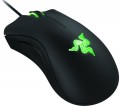Sensor resolution
Resolution of the sensor responsible for tracking mouse movements on the work surface. Specified in DPI — dots per inch.
The physical meaning of DPI as a whole is as follows. The sensor of a modern mouse works on the same principle as the camera matrix, and consists of pixels. And DPI is the number of pixels that fall on 1 inch of the underlying surface (length or width), "visible" by the sensor.
It is believed that more DPI means a more advanced sensor and mouse in general; nowadays, models for
3500 – 5000 DPI,
12000 DPI,
16000 DPI even
more are not uncommon. In a way, it is — high resolution contributes to accuracy. However, the only thing that is directly determined by this indicator is the speed at which the cursor moves across the screen: the higher the resolution of the sensor, the greater the number of pixels that the cursor will move when the mouse itself moves a certain distance. At the same time, it is worth recalling that too high a speed is even more undesirable than too low. So the real need for high DPI (
1000 and above) arises mainly when working on large screens (4K resolution and more); for more modest displays (HD and Full HD), smaller values are often enough.
Side buttons
The presence of the mouse side buttons — under the user's thumb.
The traditional, most popular option is two buttons, which by default are responsible for the “Back” and “Forward” commands in the browser, system file explorer, etc. There are more of these buttons in gaming mice; some of these models even have an interchangeable side panel that allows you to install a different number of side keys, as desired.
Anyway,
the side mouse buttons provide additional convenience and expand the list of features available from the device. At the same time, the buttons are always at hand, in fact, in instant access. This is especially handy in games: some frequently used actions can be tied to the side keys, such as reloading or a special attack. However, even in everyday use, it is much easier to press a button on the mouse than to move the cursor to the Back or Forward icon every time in the same browser.
DPI-button
A separate button that allows you to change the working resolution of the sensor on the fly without going into the software settings.
Recall that the sensitivity of the mouse and the speed of moving the cursor around the screen depend on the set DPI. For different tasks, the optimal DPI values \u200b\u200bcan also be different: for example, when working with graphic materials or maps on a large screen, high sensitivity is often convenient, and in a shooting game you may need to reduce it — for accurate aiming. Setting the sensitivity using
the DPI switch button is as simple and convenient as possible: it is available regardless of the currently running programme, including in situations where it is difficult or impossible to enter the software settings of the mouse (the same games can be used as an example). Also note that the DPI level indicator can be built into this button (see below).
DPI level indicator
An indicator showing the current resolution of the mouse sensor.
The DPI value indicator is found only in models that allow you to switch the sensor resolution and are equipped with the appropriate buttons (see above). The indicator allows you to easily monitor the set DPI settings. Note that it does not necessarily show specific numbers — conventions can be used, for example, different backlight colours.
Programmable buttons
The presence
of programmable buttons in the design of the mouse. In this case, the buttons mean not only the keys, but also the scroll wheels, which are usually able to work on pressure.
Almost all models with this feature are gaming (see "By Direction"). Usually, programming is carried out using special proprietary software, while the functionality of such a setting may be different. For example, in some models, only one action can be tied to one button, in others — a whole series of actions (such as a combination of attacks in an RPG). Often, it is possible to configure one button for different actions in different games.
However, this feature provides an additional convenience: the mouse keys are right at hand, and it is usually easier (and faster) to use them than to reach for the button (s) on the keyboard.
Weight
The total weight of the mouse. For models with a wired connection, usually, it is indicated without cable, and for devices with weight adjustment (see above) — without weights.
This parameter is important primarily for professional gaming applications, although it is often relevant for ordinary users. Theoretically, less weight promotes speed and reduces fatigue. At the same time, in fact, much depends on the personal habits and preferences of the user: a mouse that is too light may “not be felt in the hands” and not give familiar feedback. Therefore, although most mice have a lower weight limit of
60 – 80 g, however, even among professional gaming models there are much more massive devices —
120 – 140 g or
more. The lightest variety of "rodents" is laptop (see "In the direction"), among them devices come across and
less than 60 g.
Also note that the weight to some extent depends on the size and “tricked out” of the device, but there is no unambiguous dependence here: models similar in size and functionality can differ markedly in weight.

